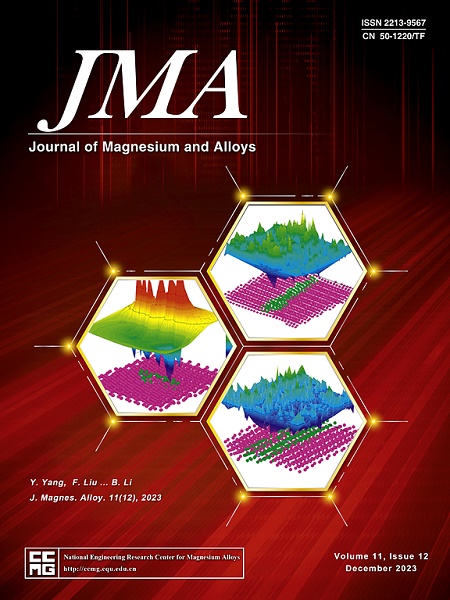Long-term high-temperature resistant biotemplated composite coating for AZ91D magnesium alloy protection
IF 15.8
1区 材料科学
Q1 METALLURGY & METALLURGICAL ENGINEERING
引用次数: 0
Abstract
Integrating different active substances through carriers and fully exerting their synergistic corrosion inhibition ability is an efficient anticorrosion strategy. Biotemplate (diatomite) was used to integrate polyaniline and sodium phosphate, an active antiseptic filler (PANI/DM/SP) was prepared in this work. Moreover, active fillers were combined with epoxy resins to prepare high-efficiency anti-corrosion coatings for magnesium alloy protection. The stability of the corrosion inhibitor (sodium phosphate) released by the active filler was analyzed by establishing a mathematical model. Simultaneously, electrochemical impedance spectroscopy tests demonstrate excellent corrosion inhibition properties of active fillers and the impedance modulus of composite coatings was three orders of magnitude higher than that of the EP coating, due to the synergistic effect of each component of the active filler. In addition, the mechanical properties of the composite coating were significantly improved, with tests showing a 51.31% increase in rub resistance and two grades of adhesion improvement (ASTM standard). The key of this work was to give full play to the slow-release characteristics of diatomite through scientific methods and promote the synergistic anticorrosion effect of sodium phosphate and polyaniline.
AZ91D镁合金长效耐高温生物模板复合涂层
通过载体整合不同的活性物质,充分发挥其协同缓蚀能力是一种有效的防腐策略。以硅藻土为生物模板整合聚苯胺和磷酸钠,制备了活性防腐填料(PANI/DM/SP)。此外,还将活性填料与环氧树脂相结合,制备了高效的镁合金防腐涂料。通过建立数学模型,分析了活性填料释放的缓蚀剂磷酸钠的稳定性。同时,电化学阻抗谱测试表明,活性填料具有良好的缓蚀性能,复合涂层的阻抗模量比EP涂层高3个数量级,这是由于活性填料各组分的协同作用。此外,复合涂层的力学性能也得到了显著改善,试验结果表明,复合涂层的耐磨性提高了51.31%,附着力提高了两个等级(符合ASTM标准)。本工作的关键是通过科学的方法充分发挥硅藻土的缓释特性,促进磷酸钠与聚苯胺的协同防腐作用。
本文章由计算机程序翻译,如有差异,请以英文原文为准。
求助全文
约1分钟内获得全文
求助全文
来源期刊

Journal of Magnesium and Alloys
Engineering-Mechanics of Materials
CiteScore
20.20
自引率
14.80%
发文量
52
审稿时长
59 days
期刊介绍:
The Journal of Magnesium and Alloys serves as a global platform for both theoretical and experimental studies in magnesium science and engineering. It welcomes submissions investigating various scientific and engineering factors impacting the metallurgy, processing, microstructure, properties, and applications of magnesium and alloys. The journal covers all aspects of magnesium and alloy research, including raw materials, alloy casting, extrusion and deformation, corrosion and surface treatment, joining and machining, simulation and modeling, microstructure evolution and mechanical properties, new alloy development, magnesium-based composites, bio-materials and energy materials, applications, and recycling.
 求助内容:
求助内容: 应助结果提醒方式:
应助结果提醒方式:


